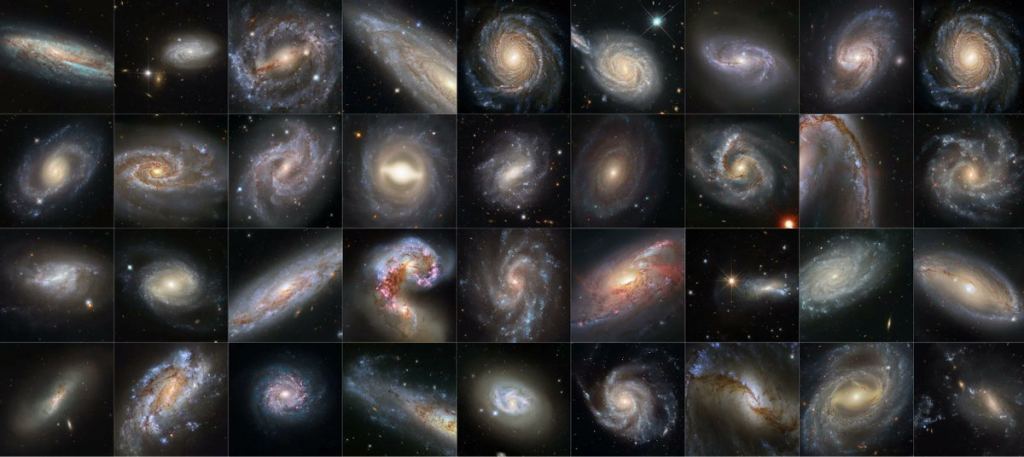Supernovae Were Discovered in all These Galaxies
By Andy Tomaswick
The Hubble space telescope has provided some of the most spectacular astronomical pictures ever taken. Some of them have even been used to confirm the value of another Hubble – the constant that determines the speed of expansion of the Universe. Now, in what Nobel laureate Adam Reiss calls Hubble’s “magnum opus,” scientists have released a series of spectacular spiral galaxies that have helped pinpoint that expansion constant – and it’s not what they expected.
The spectacular array of 36 galaxies in the lead image all have something in common. They host both a Cepheid variable and had a type Ia supernovae occur in them in the last 40 years. Combined, these two astronomical phenomena play a critical role in helping to determine how far away an object is and, consequently, how fast the Universe is expanding.
A Cepheid variable is a type of star that steadily pulsates with a very stable period and amplitude. What’s more, their luminosity is tied to their pulsating period, allowing scientists to have a direct tie between a Cepheid variable’s pulsating frequency, its luminosity, and, therefore, how far away it is. Hubble established distances to some Cepheid variables in the Andromeda Galaxy, which helped prove to the scientific community that the Milky way was only one of the billions of galaxies in the larger Universe.
Credit – Paul M Sutter YouTube Channel
Type Ia supernovae are more temporary but spectacular events that result when two stars collide in a binary system. One of these stars – a white dwarf – limits the peak luminosity of the explosion, allowing scientists to measure that luminosity as it reaches us, which in turn can be used to calculate the event’s distance.
Both of these astronomical phenomena are critical steps on the “cosmic distance ladder” that helps scientists determine how far it is to a given object. As part of its decades-long observational campaign, Hubble has captured images of more than 36 galaxies that contain both a Cepheid variable and a Type Ia supernova, allowing them to correlate and check their data against other observations as well as the two methods themselves.
“This is what the Hubble Telescope was built to do,” says Reiss of John Hopkins University. His team, known as SH0ES, has used data from Hubble to find an even more precise value of the constant named after the same astronomer. But interestingly, that value, which was derived from over 40 years of observational measurements, is at odds with the theoretical value that comes out of the stand cosmological model in modern use.
That disconnect already points to a “That’s funny” moment that Thomas Kuhn described as fundamental for revolutions in scientific understanding. It’s unclear whether something in the model needs to change or, if it does, what exactly that is. But in the meantime, we can look at the spectacular pictures that make up some of the data set that challenges our view of the cosmos and appreciate the fact that we still don’t know everything out there.
Learn More:
ESA – A dazzling Hubble collection of supernova host galaxies
Anand et al – Comparing Tip of the Red Giant Branch Distance Scales: An Independent Reduction of the Carnegie-Chicago Hubble Program and the Value of the Hubble Constant
UT – Is the Hubble constant not…Constant?
UT – Hubble’s Law
Lead Image:
36 different galaxies that Hubble captures that contain a Cepheid variable as well as a Type Ia supernova.
Credit – NASA , ESA
The post Supernovae Were Discovered in all These Galaxies appeared first on Universe Today.

June 27, 2022 at 01:36AM
via Universe Today read more...

Post a Comment